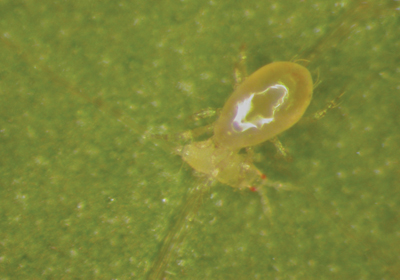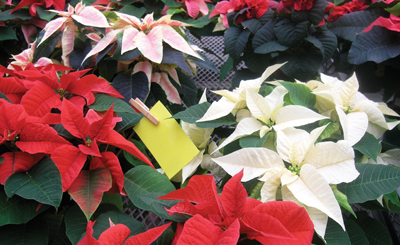
Features
Crop Protection
Inputs
Greenhouse Grower Notes: Thrips – pest priority 1, 2 and 3
January 5, 2009 By Graeme Murphy
At a recent meeting I attended, thrips was described as the first, second and third priority of the industry (from a pest management perspective). While not wanting to downplay the importance of other pests such as whitefly, aphids and mites, or diseases such powdery mildew and root rots, it is probably a fair assessment at the moment of grower concerns over their ability to control this pest.
At a recent meeting I attended, thrips was described as the first, second and third priority of the industry (from a pest management perspective). While not wanting to downplay the importance of other pests such as whitefly, aphids and mites, or diseases such powdery mildew and root rots, it is probably a fair assessment at the moment of grower concerns over their ability to control this pest.
 |
|
| The predatory mite Amblyseius swirskii feeding on a thrips larva. PHOTO COURTESY ROSEMARIJE BUITENHUIS, AAFC, HARROW Advertisement
|
“This pest,” of course, is the western flower thrips, an insect that only came to prominence as a greenhouse pest in the early 1980s. As with so many pests in the greenhouse industry, it quickly became a worldwide problem, taking advantage of the global trade in plant material. The reasons for its sudden emergence 25 years ago are not fully understood, although the development of resistance to pesticides is thought to have played a large role. Now in 2009, resistance is again the reason for its current pest status as Enemy #1 (and 2 and 3).
FEW AVAILABLE CONTROLS AND RESISTANCE IS GROWING
In Canada, we have never had an extensive armoury of pest control products effective against thrips. Twenty years ago, pesticides registered for control of thrips consisted of older chemistries such as chlorinated hydrocarbons (e.g., Lindane), organophosphates (e.g., malathion, dichlorvos, chlorpyrifos, diazinon), carbamates (e.g., bendiocarb) and synthetic pyrethroids such as deltamethrin (then called Decis – now DeltaGard). Because these were older pesticide families, resistance was common and effective control was always a battle. None of these older products could be considered as particularly effective. Since then, a number of products have been lost, including Lindane and Trumpet, so that of the older chemistries, there are now only two families available (the OPs and the synthetic pyrethroid, deltamethrin). In the same time period, there has been only one new registration for thrips in the greenhouse.
‘Success’ (spinosad) was registered for control of thrips in greenhouses in early 2006. When it was first used, it provided very effective, long-term control and for a very short period of time, thrips was no longer the most difficult pest to control in the greenhouse. In Ontario, growers started to notice a decrease in the level of control by early 2007. By the summer of 2007, lack of control was widespread and in 2008, the problem only continued to grow. It should be noted that Ontario is not the only region where resistance to spinosad has occurred. It has been documented in a number of countries around the world and greenhouse growers in the U.S. are having similar difficulties controlling thrips. In fact, the registrant of spinosad, Dow AgroSciences, voluntarily withdrew the product from sale in two Florida counties because of issues with resistance.
ROTATION OF PESTICIDES, AND their USE WITH OTHER IPM TOOLS
The above provides the background to the current situation and how we got to this point. The question now, is what can be done to control thrips? For growers who are still getting some control with pesticides – use them carefully, rotate between those families that we have registered, and use them in conjunction with other IPM strategies. Such strategies include:
| • | A good monitoring program, including a careful inspection of incoming plant material. |
| • | Good sanitation and weed control. |
| • | If greenhouses are empty for any period of time, take the opportunity to thoroughly clean and disinfest, so that the next crop at least starts without thrips pressure. |
| • | Mass trapping using yellow sticky tape (don’t wait until the thrips populations are out of control). |
| • | Screening of vents (keeps outside thrips populations from entering the greenhouse in the summer, but will do nothing for populations that have developed inside after hitchhiking in on plant material). |
PESTICIDE RESIDUES AFFECTING BIOCONTROLS
For many growers, however, pesticides are no longer an option and it is no surprise there has been a rapid increase in the use of biocontrol against thrips. However, biological control of thrips is not necessarily an easy task either, particularly in a situation where there may be a well-established population and significant pesticide residues (both of which are likely when thrips are resistant to pesticides).
Biocontrol of thrips requires careful planning and consultation with your supplier/consultant/extension specialist.
| • | A history of pesticide use in the greenhouse over the previous six months provides important background information on the likely impacts of residues on the biocontrol agents introduced. |
| • | If previously applied pesticides are likely to affect the program, then strategies have to be put in place to try to control thrips during the period of time needed for residues to dissipate. This could include using pesticides with much shorter persistence, mass trapping using yellow sticky tape, and use of soil applied biocontrol agents that will not be affected by residues on the foliage. This can be one of the most frustrating and difficult periods in a biocontrol program. |
| • | The appropriate strategies for thrips control can vary depending on the crop and the situation. The most common biocontrol agents used are predatory mites particularly Amblyseius cucumeris and A. swirskii. Biocontrol agents can also be applied to the soil to control thrips |

|
|
| Early detection is key within any IPM program.
|
BIOCONTROL QUITE EFFICIENT WITH STOCK PLANT PROGRAMS
If stock plants are being grown in the greenhouse, this is strategically the most important area in which to focus the program. The intensive nature of stock plant production and the impact of any actions taken at this stage on the finished crop highlight its importance. Biocontrol is more efficient and higher introduction rates of predators are more feasible. The environment is usually more suitable for biocontrol, with heavier canopies resulting in higher humidities and easier access for the predators from one plant to the next. Additionally, any biocontrol agents on the cuttings are carried over into the next stage of crop production.
The rooting bench is another area where biocontrol can be very efficient and effective – and for many of the same reasons as it is in stock production. It is very intensive production, environmental conditions are usually favourable for biocontrol agents, and thrips levels are often at low levels (unless cuttings are heavily infested). If cuttings are purchased from an outside source, it is important to find out their pesticide history, since, as noted above, it can have a significant impact on success. It should be noted however, that in the warm, humid environment of the rooting bench, and as young plants grow quickly, residues are likely to dissipate more quickly than when applied to a standing crop in the greenhouse.
USING TRAP PLANTS TO ATTRACT THRIPS FROM CROP
In the finished crop and at final spacing, biocontrol can become more problematic. However, there are still ways to improve efficiency. Take note of which varieties are most attractive to thrips. If there are clear differences in susceptibility, focus biocontrol (and monitoring) efforts on these varieties.
Some growers are using trap plants (plants that are highly attractive to thrips) as a way of focusing the population into specific areas. Depending on circumstances, these plants can be removed periodically or treated with high introductions of biocontrol agents. There is plenty of room for creative thinking.
Make use of the technical support offered by biocontrol companies, distributors and consultants. They have a vast wealth of experience and knowledge. Talk with other growers who are using biocontrol and make use of their experience as well. Most successful programs are a team effort.
Finally, realize that biocontrol is not going to be a short-term solution. It has to be looked at as a long-term commitment and a fundamental change in thinking. Don’t expect perfect control in two to three months when we haven’t seen it from pesticides for 25 years.
Since their emergence as a major greenhouse pest in the early 1980s, western flower thrips has consistently ranked as one of the most difficult pests to control, not just in Canada, but in greenhouse production areas around the world. Timely development of new pesticides has kept our heads above water, but at the moment it is difficult to foresee any new developments that will provide relief for growers in the near future. As a result, biocontrol programs are becoming more widely used, and while still not perfect, offer greater potential for success than the alternative.
Graeme Murphy is the greenhouse floriculture IPM specialist with the Ontario Ministry of Agriculture, Food and Rural Affairs at Vineland. • 905-562-4141, ext. 106, or graeme.murphy@ontario.ca
Print this page